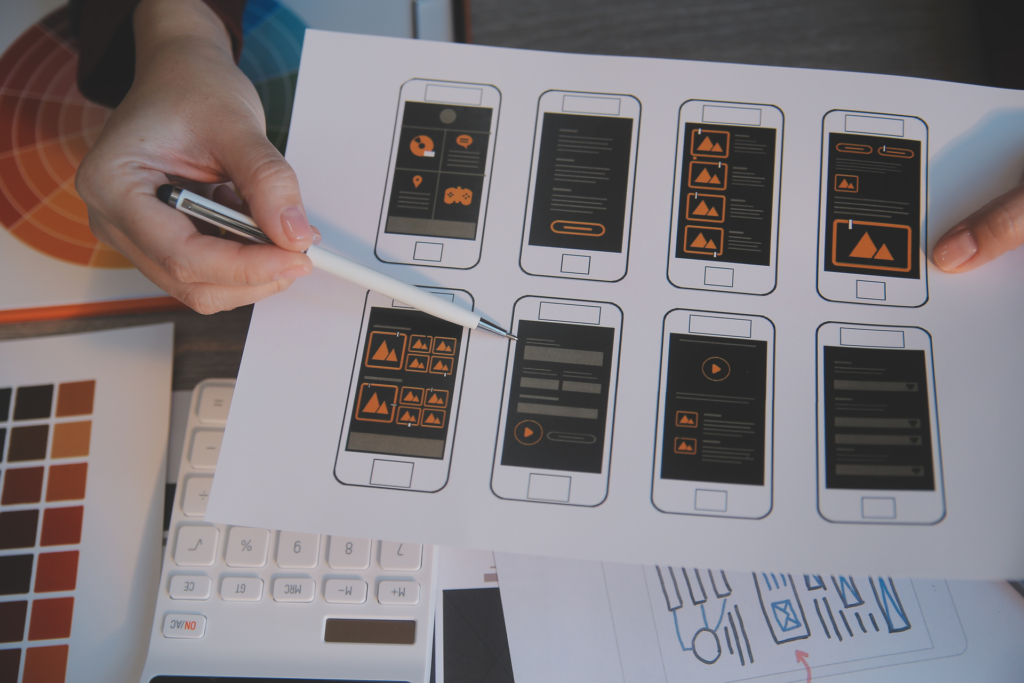Table of contents:
Product design is a crucial stage of every project. It helps you understand the product’s needed features, aesthetics, and appeal. Various meetings and presentations during this stage lead to the ideal product design. Various visual representations are also employed to display these proposed templates. Among the numerous options, users often make comparisons between the wireframe vs prototype. One side claims the wireframe and prototype are identical, while the other claims one is more important. We’ll explore the similarities and differences between these visual elements. And we’ll discover how important they are in your product design journey.
What is a Wireframe?
A wireframe is a basic visual display of a product’s layout. It’s like a sketch that shows the simplest elements and features. The detailing may be different depending on the type, but its function remains the same. At first glance, it reveals the design’s origin, or the starting point.
They serve as the conceptual framework for the design of products. For software projects, they showcase the app or website’s core functionalities. These product discovery techniques lack color, as they solely concentrate on functionality and layout. Think of them as blueprints for a house—you only see the structure, not the paintwork.
This means you only focus on the software’s primary layout during project discovery. Therefore, these layouts lack color schemes, design elements, and relevant content. They also serve as the most essential base of UX/UI design.
This is because choosing the right layout is crucial for achieving the best possible user interaction. So, developers must be in uniform agreement before mounting features on the established framework.
Wireframe Types
Products have different forms depending on the industry. But they all fall under three general categories, each defined by the degree of detailing they allow. These are low, mid, and high-fidelity wireframes. Let’s explore each in detail:
- Low-Fidelity: These types are usually handdrawn and are the simplest. While some developers create them on paper, others use a digital whiteboard. Low-fidelity wireframes are perfect for brainstorming sessions because they’re quick.
- Mid-Fidelity: These product discovery techniques add a bit more detail than low-fidelity ones. They typically include user flow and key elements in their sketches. Developers can compare the core layout in more detail at mid-fidelity.
- High-Fidelity: These types offer the highest level of detail and often incorporate more visual elements. Though they’re still void of interactive features, you get a closer impression of the final product. It’s the go-to option when software projects can’t afford prototyping.
Wireframe Benefits and Limitations
Wireframes are a clear visualization of the software’s final design. Everyone can fully understand the layout due to its simplicity. They are also more cost-effective and quicker to create, providing a collaborative blueprint for development. Plus, the layout means developers can concentrate on usability testing and user flow.
However, the lack of interaction details prevents users from testing them. Furthermore, without a solid understanding of software designs, interpreting them in product discovery could be challenging.
What is a Prototype?
A prototype is a product sample that allows users to test its functions and design. This means it has an interactive advantage, letting people check how the final product will work. Sometimes, it may even be the first version of the original software, which undergoes consistent updates based on user feedback.
These allow you to test the software’s performance during a project’s discovery phase. So, they often come with features, interface designs, and color schemes. You’ll be interacting with the actual software, though not in its final form. Feedback at the end of the experience helps developers improve the software.
Prototypes come in various forms, and each performs a different purpose. For instance, some prototypes use real-time data to test the product’s performance, which explains their complex design.
Others, on the other hand, are much simpler, as they focus on verifying the viability of a concept. Some high-fidelity options focus on assessing the user experience of a product. Low-fidelity types prioritize the exploration of user interfaces.
This implies that prototypes can verify a software concept much more thoroughly. But their core function is to gather feedback from users so the developers can adjust the design.
Prototype Benefits and Limitations
Prototypes are more test-friendly, meaning users can interact with the features and drop feedback. They also pull in feedback faster, so developers can run quicker improvements. By adding only necessary features, you also avoid additional financial risks. Their hands-on design means team members and stakeholders can grasp the concept’s full scope without issues.
However, this process of product discovery still has certain limitations, such as those listed below:
- Attracts a significant cost
- It might be too expensive for smaller projects.
- Takes time to build
- Requires programming and UX/UI expertise
Wireframe vs Prototype: When to Use Each
Though an obvious distinction lies between a wireframe vs prototype, you may still wonder what makes them so separate. Both visual representations offer unique functions in project development processes. This implies that presenting them at different stages of the project discovery phase is optimal.
Wireframing works best during the brainstorming stage. Its whiteboard nature enables team members to make instantaneous inputs. One can craft a more concrete idea from its abstract layout. This is also why it works at feedback levels, especially from stakeholders. And its basic structure means it’s perfect for testing layouts and planning the final feature alignments.
Prototyping works best in user testing phases since they carry the features. Since they’re more detailed, they offer a better understanding of the proposed software. This makes them ideal for presenting proposed software to stakeholders and users for review. They also serve as an excellent pre-development representation, which can significantly reduce rework costs once the project commences.
However, it’s not always advisable to prioritize a prototype over a wireframe. Both elements are essential in product development, though they perform at different stages. Therefore, the best advice would be to combine both elements in software development. The first can help with the layout, while the second offers a more detailed sample.
How We Can Help
North South Tech embraces both wireframes and prototypes as essential tools in our design process, recognizing that each serves a unique purpose in bringing your vision to life. We’ve moved beyond the either-or debate, instead crafting a development approach that harnesses the strengths of both.
Our process begins with rapid wireframe exploration to nail down your core layout and functionality requirements, then evolves into interactive prototypes that let you experience your product before full development begins. This dual approach has consistently delivered stronger results for our clients, eliminating costly revisions and ensuring the final product truly matches your vision.
Talk with our design team about your next project; we’ll show you how this balanced methodology can transform your idea into reality. Schedule a free consultation today.





